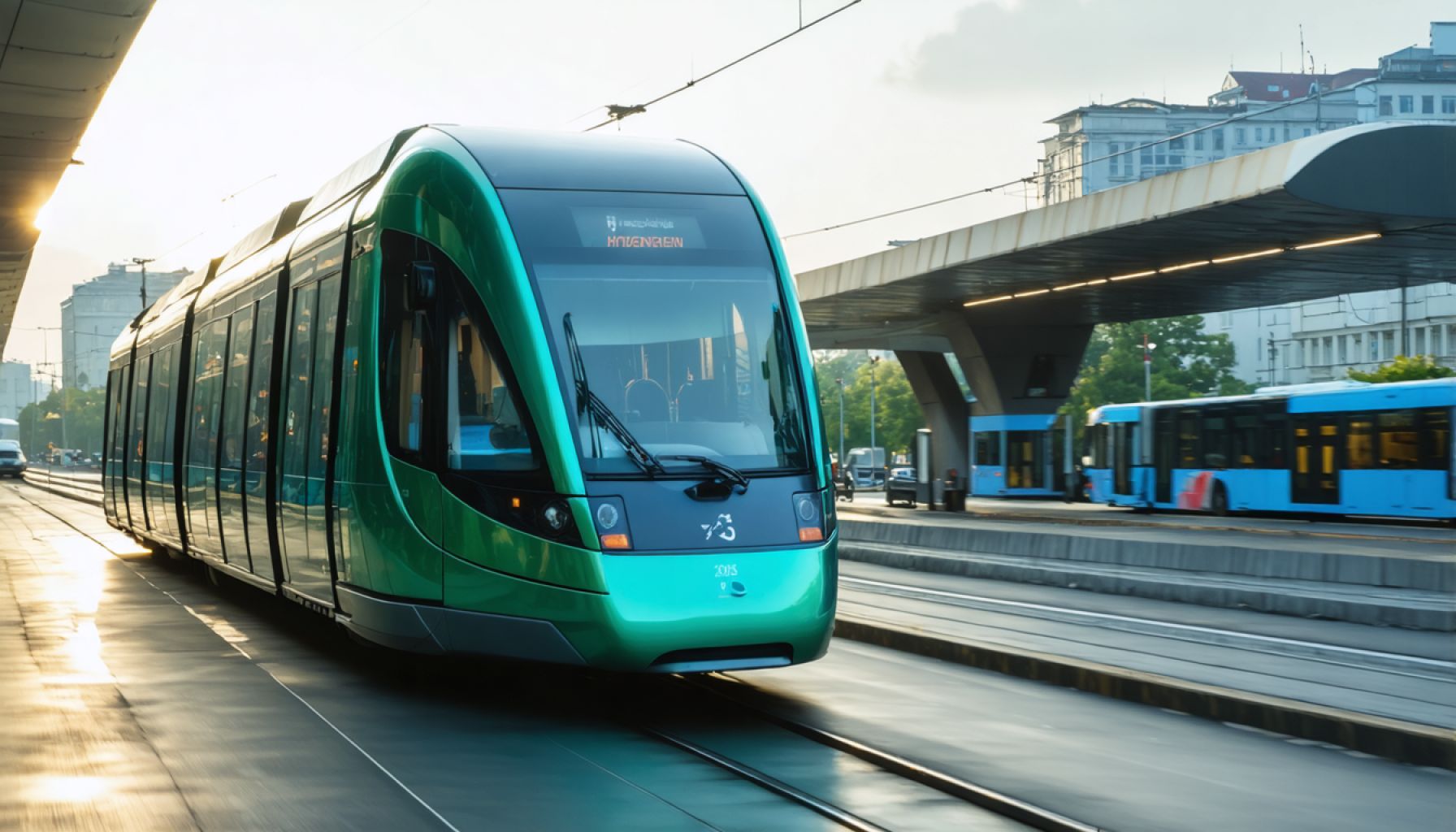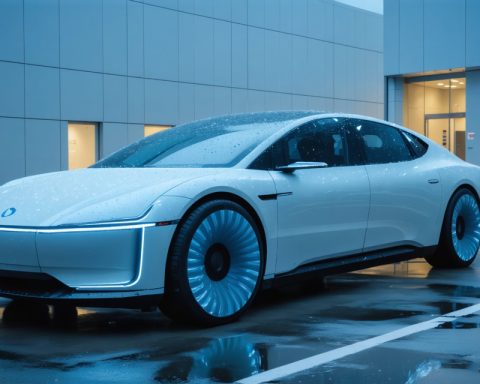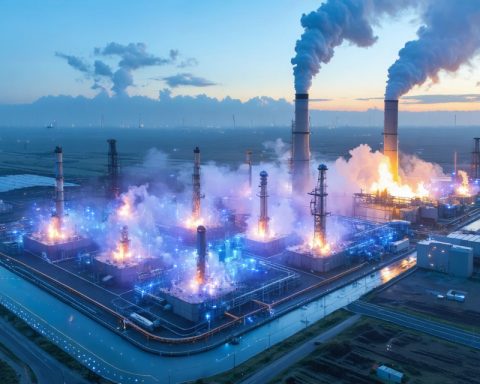- Hydrogen buses mark a shift towards cleaner public transportation by emitting only water vapor, reducing urban pollution and noise significantly.
- These buses operate on hydrogen fuel cells, converting hydrogen into electricity with zero emissions, boasting efficiency up to three times greater than traditional engines.
- With refueling times comparable to conventional buses, hydrogen buses offer practicality for busy urban settings.
- Offering longer ranges than electric buses, they are suitable for extended routes and challenging terrains.
- The use of green hydrogen, produced via renewable energy sources, enhances the sustainability of this technology.
- Hydrogen-fueled buses highlight human innovation in addressing climate challenges, pushing towards greener urban environments.
A sleek, whispering giant rolls down the city streets, leaving only a gentle hum in its wake. This is not a scene from a science fiction movie but the current transformation of public transportation. As cities battle climate change, one key player emerges from the shadows — hydrogen-fueled buses, heralding a new era of cleaner street mobility.
Imagine buses that breathe clean air, emitting nothing but water vapor. These hydrogen-powered coaches promise to slash emissions, echoing a much-needed call for sustainability in bustling metropolises worldwide. This innovation isn’t just a dream; it’s a bold reality charging ahead in cities like London, Tokyo, and Los Angeles.
Hydrogen buses operate by converting hydrogen gas into electricity using fuel cells, a process that results in zero emissions. This system offers a higher efficiency rate compared to traditional combustion engines, producing up to three times more energy per kilogram of fuel. Plus, the refueling time mirrors that of conventional buses — just minutes!
Fleets of public transport contribute heavily to urban pollution and noise, yet hydrogen buses promise a silent revolution. Their operations are so quiet that even the throbbing heart of a busy city seems to beat a little softer. For commuters, this means a more peaceful, pleasant ride and a cleaner atmosphere to breathe.
It’s not just the silence that speaks volumes. Hydrogen buses boast longer ranges than electric ones, making them ideal for sprawling or rugged terrains. A single fill-up could power a bus for hundreds of kilometers, effortlessly covering extended routes without the need for frequent stops or recharging.
Yet, eyes often wander to green hydrogen — produced by electrolyzing water using renewable energy. This cleaner production method ensures that hydrogen buses capitalize on a genuinely sustainable loop, aligning perfectly with global efforts to cut down carbon footprints.
As public awareness grows, the push for hydrogen innovation cements itself as not merely necessary but essential. Transitioning to hydrogen-powered transportation embodies the harmony between groundbreaking technology and environmental preservation. Such advancements remind us that innovation isn’t just about new gadgets but improving the world we live in.
The takeaway? Hydrogen-fueled buses underscore the potential of human innovation to conquer pressing global challenges, driving us headlong into a future where clean, green streets are the norm, not just the exception.
Explore the Future of Urban Mobility with Hydrogen-Powered Buses
Overview and Benefits
The transition to hydrogen-fueled buses is reshaping urban mobility by offering a sustainable and efficient alternative to traditional diesel-powered vehicles. Hydrogen buses operate through fuel cells that convert hydrogen gas into electricity, generating only water vapor as a byproduct. This advancement not only reduces emissions but also promotes a quieter and more efficient transit model.
How Hydrogen Buses Work
1. Fuel Cell Technology: Hydrogen buses use a fuel cell to combine hydrogen gas with oxygen from the air, producing electricity, heat, and water. This process is clean and efficient.
2. Efficiency: Hydrogen fuel cells provide up to three times more energy per kilogram of fuel than gasoline or diesel.
3. Refueling Time: The refueling of hydrogen buses takes minutes, similar to conventional buses, offering an operational advantage over longer-charging battery-electric buses.
Real-World Use Cases
– Long-Range Capability: Hydrogen buses can travel hundreds of kilometers on a single fill-up, making them suitable for routes with longer distances or less frequent stops.
– Adoption in Major Cities: Leading cities like London, Tokyo, and Los Angeles have already integrated hydrogen buses into their public transit systems, setting examples for global adoption.
Industry Trends and Market Forecasts
– Growing Investments: Increased investments in hydrogen infrastructure and technology development signal a substantial growth phase for hydrogen buses.
– Market Projections: According to MarketsandMarkets, the global hydrogen fuel cell vehicle market size is projected to reach USD 8,643 million by 2028, indicating a strong future for hydrogen buses.
Features, Specs, and Pricing
– Features: Zero emissions, quiet operation, and fast refueling.
– Range: Capable of traveling extensive distances on a single tank.
– Cost: Initial costs can be high, but economies of scale and technology advancements may lower prices in the future.
Limitations and Controversies
– Infrastructure Needs: Comprehensive hydrogen refueling infrastructure is critical for widespread adoption.
– Production Concerns: While green hydrogen (produced using renewable energy sources) is ideal, much of today’s hydrogen is derived from natural gas, which can undermine environmental benefits.
Security and Sustainability
– Safety: Hydrogen is highly flammable, raising safety concerns that need constant attention and innovation in storage and delivery methods.
– Sustainability: To maximize environmental benefits, the production of green hydrogen is essential, ensuring a sustainable and carbon-neutral fuel source.
Quick Tips for Adoption
1. Policy Support: Governments can encourage hydrogen bus adoption through subsidies, tax incentives, and policy frameworks.
2. Public Awareness: Raising awareness about the benefits of hydrogen buses will support transition efforts and acceptance.
3. Infrastructure Investment: Investments in green hydrogen production and refueling infrastructure are crucial.
Conclusion
Hydrogen-fueled buses present an opportunity to drastically reduce urban pollution and improve city life quality. By embracing this technology, cities can pave the way for cleaner and greener mobility. It’s crucial to support infrastructure development and green hydrogen production to maximize the potential of hydrogen-powered transport.
For further insights into the advancements in hydrogen technology, visit Toyota and Ballard.















